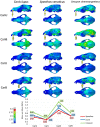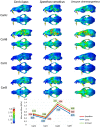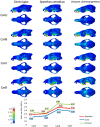Different, but the same: Inferring the hunting behaviour of the hypercarnivorous bush dog (Speothos venaticus) through finite element analysis
- PMID: 36485003
- PMCID: PMC10008295
- DOI: 10.1111/joa.13804
Different, but the same: Inferring the hunting behaviour of the hypercarnivorous bush dog (Speothos venaticus) through finite element analysis
Abstract
Cerdocyonina is a clade composed by the South-American canids in which the bush dog (Speothos venaticus) is one of the most elusive species. Known for its unique morphology within the group, this small, bear-like faced canid is the only member of the clade adapted to hypercarnivory, an almost exclusively meat-based diet currently present only in usually large, pack-hunting canids such as the grey wolf (Canis lupus). However, much of the biology of the bush dog is poorly understood, and inferences about its ecology, hunting strategies and diet are usually based on observation of captive individuals and anecdotal records, with reduced quantitative data to offer support. Here, we investigated the craniomandibular functional morphology of the bush dog through finite element analysis (FEA). FEA was employed to model the biting behaviour and to create extrinsic and intrinsic functional scenarios with different loads, corresponding to different bites used to subdue and process the prey. For comparison, the same modelling was applied to the skull of a grey wolf and a grey fox (Urocyon cinereoargenteus). Our analysis showed that the bush dog's responses to loading are more similar to the wolf's than to the fox's in most scenarios, suggesting a convergent craniomandibular functional morphology between these two hypercarnivorous species, despite their distinct phylogenetic positions and body sizes. Differences between the three taxa are noteworthy and suggested to be related to the size of the usual prey. The modelled bite force for the bush dog is relatively strong, about half of that estimated for the wolf and about 40% stronger than the fox's bite. The results strengthen with quantitative data the inferences of the bush dog as a pack-hunting predator with prey size similar to its own, such as large rodents and armadillos, being specialised in subduing and killing its prey using multiple bites. Its similarity to the wolf also confirms anecdotal accounts of predation on mammals that are much larger than itself, such as peccaries and tapirs. These data highlight the ecological specialisation of this small canid in a continent where large, pack-hunting canids are absent.
Keywords: Canidae; Cerdocyonina; biomechanics; finite element analysis; hypercarnivory.
© 2022 The Authors. Journal of Anatomy published by John Wiley & Sons Ltd on behalf of Anatomical Society.
Conflict of interest statement
The authors declare no conflict of interest.
Figures








References
-
- Allen, M.L. , Avrin, A.C. , Farmer, M.J. , Whipple, L.S. , Alexander, E.P. , Cervantes, A.M. et al. (2021) Limitations of current knowledge about the ecology of Grey foxes hamper conservation efforts. Journal of Threatened Taxa, 13(8), 19079–19092.
-
- Anapol, F. , Shahnoor, N. & Ross, C.F. (2008) Scaling of reduced physiologic cross‐sectional area in primate muscles of mastication. In: Vinyard, C. , Ravosa, M.J. & Wall, C. (Eds.) Primate craniofacial function and biology. Boston: Springer, pp. 201–216.
-
- Attard, M.R.G. , Chamoli, U. , Ferrara, T.L. , Rogers, T.L. & Wroe, S. (2011) Skull mechanics and implications for feeding behaviour in a large marsupial carnivore guild: the thylacine, Tasmanian devil and spotted‐tailed quoll. Journal of Zoology, 285(4), 292–300.
-
- Barnett, A. , Shapley, R. & Engstrom, M. (2001) Records of the bushdog, Speothos venaticus (Lund, 1842) from Guyana. Mammalia, 65(2), 232–236.
-
- Beisiegel, B.D.M. (1999) Contribuição ao estudo da história natural do cachorro do mato, Cerdocyon thous, e do cachorro vinagre, Speothos venaticus . PhD Thesis. São Paulo: Universidade de São Paulo.
Publication types
MeSH terms
LinkOut - more resources
Full Text Sources

